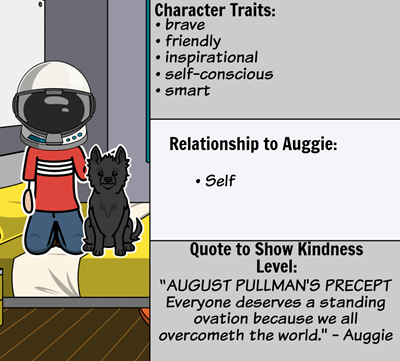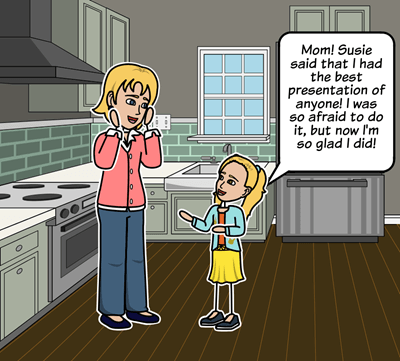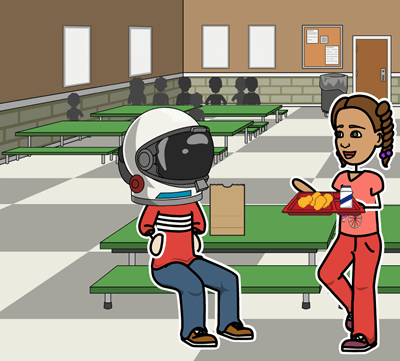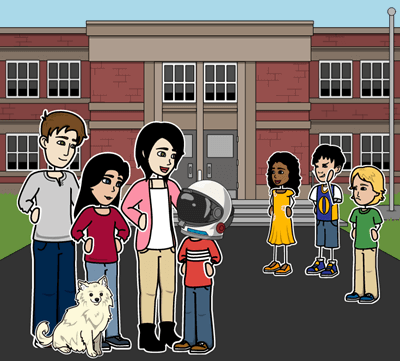Lesson Plan Overview
Understanding a story's plot is very important. Each piece needs to happen in a particular order for the story to make sense. In Wonder, readers must first be introduced to August and his disorder before we can understand why other children might want to make fun of him. We also need to learn about the way Daisy, Auggie's dog, treats him and how Auggie thinks she sees him, to understand his deep connection to her.
In this activity, students create their own plot diagram of Wonder including Exposition, Conflict, Rising Action, Climax, Falling Action, and Resolution. Each part should be labeled and include text to explain what is happening in each cell.
Template and Class Instructions
(These instructions are completely customizable. After clicking "Copy Activity", update the instructions on the Edit Tab of the assignment.)
Student Instructions
Create a visual plot diagram of Wonder.
- Click "Start Assignment".
- Separate the story into the Exposition, Conflict, Rising Action, Climax, Falling Action, and Resolution.
- Create an image that represents an important moment or set of events for each of the story components.
- Write a description of each of the steps in the plot diagram.
Lesson Plan Reference
Student Rubric
(You can also create your own on Quick Rubric.)
| Proficient 33 Points | Emerging 25 Points | Beginning 17 Points | |
|---|---|---|---|
| Plot Images | Cells include images that convey events in the corresponding stage of the plot. The images represent an important moment and exemplify the descriptions below them. | Cells include one or two images that convey events from an incorrect stage of the plot. Most images represent an important moment and exemplify the descriptions below them. | Cells include three or more images that convey events from an incorrect stage of the plot. Images depict minor and inimportant moments or do not reflect the descriptions below them. |
| Plot Text | The storyboard correctly identifies all six stages of the plot. The text for each of the six cells correctly breaks down the plot events into appropriate stages. The text gives a logical overview of the plot and includes the most significant events of the book. | The storyboard misidentifies one or two stages of the plot. The text for each of the six cells breaks down most of the plot events into appropriate stages. The text gives a logical overview of the plot, but may omit some significant events of the book. | The storyboard misidentifies three or more stages of the plot. The text for each of the six cells does not correspond to the events of that stage. Overall plot description is not logical. |
| Spelling and Grammar | Spelling and grammar is exemplary. Text contains few or no mistakes. | Text contains some significant errors in spelling or grammar. | Text contains many errors in spelling or grammar. |
Lesson Plan Overview
Understanding a story's plot is very important. Each piece needs to happen in a particular order for the story to make sense. In Wonder, readers must first be introduced to August and his disorder before we can understand why other children might want to make fun of him. We also need to learn about the way Daisy, Auggie's dog, treats him and how Auggie thinks she sees him, to understand his deep connection to her.
In this activity, students create their own plot diagram of Wonder including Exposition, Conflict, Rising Action, Climax, Falling Action, and Resolution. Each part should be labeled and include text to explain what is happening in each cell.
Template and Class Instructions
(These instructions are completely customizable. After clicking "Copy Activity", update the instructions on the Edit Tab of the assignment.)
Student Instructions
Create a visual plot diagram of Wonder.
- Click "Start Assignment".
- Separate the story into the Exposition, Conflict, Rising Action, Climax, Falling Action, and Resolution.
- Create an image that represents an important moment or set of events for each of the story components.
- Write a description of each of the steps in the plot diagram.
Lesson Plan Reference
Student Rubric
(You can also create your own on Quick Rubric.)
| Proficient 33 Points | Emerging 25 Points | Beginning 17 Points | |
|---|---|---|---|
| Plot Images | Cells include images that convey events in the corresponding stage of the plot. The images represent an important moment and exemplify the descriptions below them. | Cells include one or two images that convey events from an incorrect stage of the plot. Most images represent an important moment and exemplify the descriptions below them. | Cells include three or more images that convey events from an incorrect stage of the plot. Images depict minor and inimportant moments or do not reflect the descriptions below them. |
| Plot Text | The storyboard correctly identifies all six stages of the plot. The text for each of the six cells correctly breaks down the plot events into appropriate stages. The text gives a logical overview of the plot and includes the most significant events of the book. | The storyboard misidentifies one or two stages of the plot. The text for each of the six cells breaks down most of the plot events into appropriate stages. The text gives a logical overview of the plot, but may omit some significant events of the book. | The storyboard misidentifies three or more stages of the plot. The text for each of the six cells does not correspond to the events of that stage. Overall plot description is not logical. |
| Spelling and Grammar | Spelling and grammar is exemplary. Text contains few or no mistakes. | Text contains some significant errors in spelling or grammar. | Text contains many errors in spelling or grammar. |
How To Use a Plot Diagram to Make Sense of a Story
Read the Story
Depending on your class, teachers can decide to chunk the story for students or to read through the entire story at once. The teacher can give hints to students as they move through the plot about which part of the narrative arc is being read.
Fill In Parts of the Story on a Diagram
Students can use bullet points to fill in the parts of the story, writing the setting and characters near the exposition, etc. As they work their way up the mountain to the climax, students may need scaffolding to identify the parts of the plot.
Label and Describe the Parts
Help students to describe each moment of the plot to further cement their ideas. Using their own words to describe each part will internalize the lesson.
Frequently Asked Questions about Wonder Plot Diagram and Summary
How does a plot diagram tool help students make sense of a story?
Students can use a plot diagram to help them make sense of the order of events in the story. This keeps each part of the action organized in a visual way, and helps students think more carefully and critically about it as they understand what is taking place.
What is the exposition in a story?
The exposition of a story comes at the very beginning of the story and exposes the characters and the setting so the reader knows what the story is about.
What are some types of resolutions?
The resolution of the story is when the story is resolved and things start to wrap up. Sometimes the main character lives happily ever after, sometimes sad ever after, and sometimes even dead ever after!
More Storyboard That Activities
Wonder
Testimonials

“By using the product, they were so excited and they learned so much...”–K-5 Librarian and Instructinal Technology Teacher

“I'm doing a Napoleon timeline and I'm having [students] determine whether or not Napoleon was a good guy or a bad guy or somewhere in between.”–History and Special Ed Teacher

“Students get to be creative with Storyboard That and there's so many visuals for them to pick from... It makes it really accessible for all students in the class.”–Third Grade Teacher
© 2025 - Clever Prototypes, LLC - All rights reserved.
StoryboardThat is a trademark of Clever Prototypes, LLC, and Registered in U.S. Patent and Trademark Office












